战略管理流程讲义(英文版!05资料
战略管理课件英文版Ch6CorporateLevelStrategy48P

21
Levels and Types of Diversification
Moderate to High Levels of Diversification
Related Constrained
<70% of revenues from dominant business; all businesses share product, technological and distribution linkages
28
Managerial Motives to Diversify
Managers have motives to diversify:
– diversification increases size; size is associated with executive compensation
– diversification reduces employment risk – effective governance mechanisms may restrict
7
This is what Pepsi used to look like
8
Pepsi’s experiment with fast food
Pepsi acquires Pizza Hut in 1977, Taco Bell in 1978 and KFC in 1986.
In 1997, Pepsi spins off all three as Tricon ($11B with 29,000 restaurants). They are now part of Yum! Brands.
战略管理英文版最新版教学ppt课件第1章

Part 1 Strategy Analysis 1-2
LO 1-1 Define competitive advantage, sustainable competitive advantage, competitive disadvantage, and competitive parity.
LO 1-7 Critically evaluate the role that different stakeholders play in the firm’s quest for competitive advantage.
1-8
EXHIBIT 1.1 Industry, Firm, and Other Effects Explaining Superior Firm Performance
❖ Yahoo buys Overture for its own search product
• Microsoft launches its own search in 2009
➢ Bing now partnered with Yahoo
1-4
Microsoft and Google – Online Search
• What’s happening in our chapter opener?
➢ Why might Microsoft have acted the way it did?
➢ If they had not killed Keywords, would Microsoft have beat Google to search and linked ads?
战略管理流程讲义 全套课件

1998 Country
1 Singapore 3 United States 2 Hong Kong 6 Taiwan 5 Canada 8 Switzerland 10 Luxembourg 4 United Kingdom 7 Netherlands 11 Ireland 15 Finland 14 Australia 13 New Zealand 12 Japan 9 Norway 17 Malaysia 16 Denmark 30 Iceland 23 Sweden 20 Austria 18 Chile 19 Korea 22 France 27 Belgium 24 Germany 2第5八页,共S3p41a页in。
Competitiveness Index 1999 2.12 1.58 1.41 1.38 1.33 1.27 1.25 1.17 1.13 1.11 1.11 1.04 10.1 1.00 0.92 0.86 0.85 0.59 0.58 0.37 0.57 0.46 0.44 0.39 0.37 0.16
The global economy is changing
• People, goods, services and ideas move freely across geographic boundaries
• New opportunities emerge in multiple global markets
Acquisitions & Restructuring
Chapter 8
International Strategy
Chapter 9
Cooperative Strategies
Strategy Implementation
战略管理流程讲义(英文版!08资料

Identify International Opportunities
Increased Market Size Return on Investment Economies of Scale and Learning Location Advantage
Explore Resources and
- Can spread costs over a larger sales base - Increase profit per unit
Location Advantages
Low cost markets may aid in developing competitive advantage
May achieve better access to: - Raw materials - Lower cost labor
Chapter 8
International Strperative Strategies
Strategy Implementation
Chapter 10 Corporate Governance
Chapter 12 Strategic Leadership
Chapter 11 Structure & Control
- Key customers - Energy
- Key suppliers
- Natural resources Ch8-6
Porter’s Determinants of National Advantage
Modes of Entry
Exporting
Exporting
Strategic Alliances
Management Problems and Risk
战略管理流程讲义(英文版!03资料

And... Will environmental changes make our core competencies obsolete?
Are substitutes available for our core competencies?
Are our core competencies easily imitated?
such as capital equipment, skills of employees, brand names, finances and talented managers
Ch3-8
Resources
What a firm Has...
What a firm has to work with: its assets, including its people and the value of its brand name
Ch3-5
Discovering Core Competencies
Resources
* Tangible * Intangible
Ch3-6
ResouБайду номын сангаасces
What a firm Has...
What a firm has to work with:
its assets, including its people and the value of its brand name
* Financial * Physical * Technological * Organizational
Intangible Resources
* Valuable * Rare * Costly to Imitate * Nonsubstitutable
战略管理流程讲义(英文版!06资料

Tangible Resources Intangible Resources
Ch6-7
Motives, Incentives, and Resources for Diversification
Resources
Incentives
Managerial Motives
Chapter 6
Corporate-Level Strategy
Ch6-1
Strategic Inputs
Chapter 2 External Environment
Chapter 3 Internal Environment
Strategic Intent Strategic Mission
The Strategic Management
Corporate Strategy is what makes the corporate whole add up to more than the sum of its business unit parts
Ch6-4
Levels and Types of Diversification
Low Levels of Diversification
Motives to Enhance Strategic Competitiveness
Resources Incentives
Economies of Scope Market Power
Financial Economies
Managerial Motives
Ch6-6
Motives, Incentives, and Resources for Diversification
战略管理英文版最新版教学课件第1章
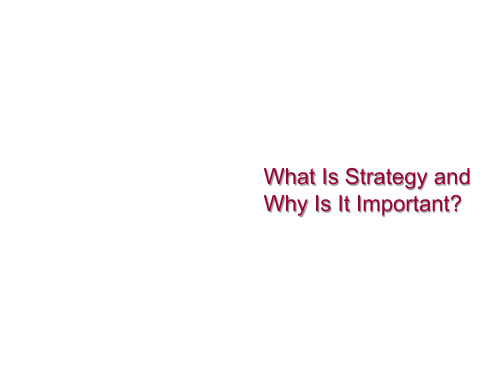
LO 1-5 Outline how business models put strategy into action.
• Operational effectiveness
➢ Enterprise Resource Planning (ERP)
➢ Benchmarking
➢ Six Sigma
➢ “Necessary but not sufficient” such as Lean Manufacture
1-11
Strategy Across the Levels
LO 1-6 Describe and assess the opportunities and challenges managers face in the 21st century.
LO 1-7 Critically evaluate the role that different stakeholders play in the firm’s quest for competitive advantage.
• What’s happening in our chapter opener?
➢ Why might Microsoft have acted the way it did?
➢ If they had not killed Keywords, would Microsoft have beat Google to search and linked ads?
chap5战略管理英语版
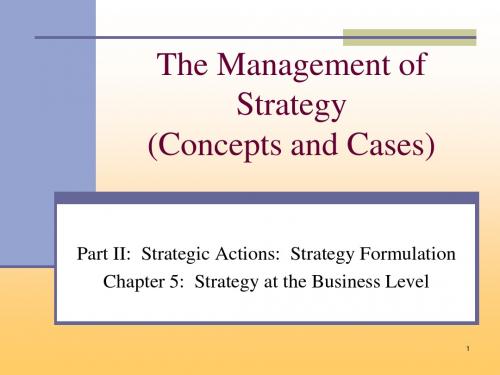
11
Customers: Their Relationship with Business-Level Strategies
(Cont’d)
…Five components of customer relationships 4. What: Determining which customer needs to satisfy
5
Chapter 5: Strategy at the Business Level
Overview: Five content areas
Defining business-level strategy Relationship between customers and strategy Differences in business-level strategies 5-Forces Risks of business-level strategies
但是顾客的选择还和竞争者有关
所以竞争战略的实质是:如何给予顾客较之竞
争者更多的价值
15
提升顾客价值(1)
顾客认知利益:顾客可以识别的各种效用,具体
包括产品的功能、质量、服务、包装、企业形象 等等 顾客认知利益是一种带有主观认知色彩的概念, 是顾客在使用产品或接受服务中获得的实在感受 (受益)。
7
Introduction
(Cont’d)
Customers are the foundation of successful
business strategies
Who will be served by the firm What needs those target customers have that firm will satisfy How those needs will be satisfied by the firm
战略流程报告英文

“Can America Lose These Jobs and Still Prosper?”
– July 2003
“American legislators are accusing India of stealing jobs”
2 Average 1996-99
3 Average 1989-2000
4 Average 2003-13
Source: NBER; BLS; Kletzer; McKinsey Global Institute
8
20030520DL-ZXE332(ITES, Board Pres.)(JS)-7
5
INDIA CAPTURES 33 CENTS FROM EACH DOLLAR OF SPEND OFFSHORED BY THE U.S.
Value accrued from $1 of U.S. spend offshored1
Dollars; 2002
0.33
0.03
0.01
0.09
0.10
• Off-shored jobs small fraction of
expected retirements/lay-offs
Negative emotional impact at the customer equally real
• Real people and communities are
• Will the BPO
phenomenon plateau out in the next few years?
• Even if it survives,
战略管理(罗宾斯管理学第版讲义全集-英文版)资料
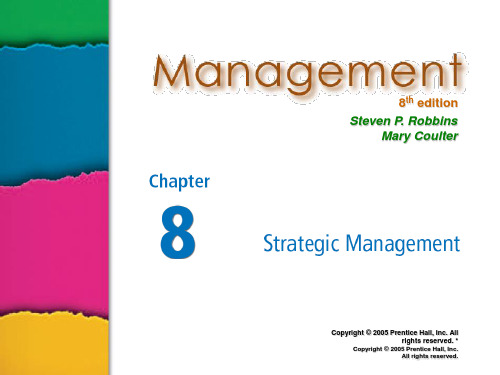
• Discuss the implications of dynamic and uncertain environments on organizational strategy.
• Explain the rule of three and its significance to strategic management.
strategy. • Describe two renewal strategies.
Copyright © 2005 Prentice Hall, Inc. All rights reserved. *
8–3
L E A R N I N G O U T L I N E (cont’d)
Follow this Learning Outline as you read and study this chapter.
• Discuss what studies of the effectiveness of strategic management have shown.
The Strategic Management Process
• List six steps in the strategic management process.
Copyright © 2005 Prentice Hall, Inc. All rights reserved. *
8–4
L E A R N I N G O U T L I N E (cont’d)
Follow this Learning Outline as you read and study this chapter.
战略管理-第五章公司战略(企业战略管理整套教学讲义)
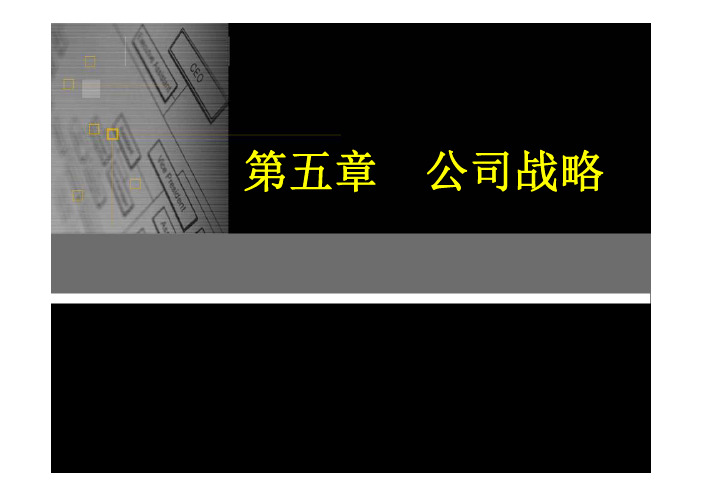
第六章章战第五章公司战略公司战略名人名言明天总会到来,又总会与今天不同。
如果不着眼于未来,最强有不同如果不着眼于未来最强有力的公司也会遇到麻烦。
——杜拉克本章的主要内容z公司战略的种类z各种战略的优劣势比较z案例分析z战略分析工具介绍本章思考讨论题1.在采用每种公司战略时应注意哪些问题?22.为什么大多数企业倾向于采用发展战略?3.以一个实际企业为研究对象,鉴别出它所采取的战略.4. 请比较下企业实行发展战略不同方式4请比较一下企业实行发展战略不同方式的优缺点。
定义在企业外部环境约束下企特点企业对过去的成绩满意在企业外部环境约束下,企业准备在战略规划期使其资源分配和经营状况基本保持在目前状态和水平上的战略企业过去的战略是成功的企业以过去的产品和服务来满在目前状态和水平上的战略。
足社会(没有创新)外部环境内部实力决定9外部环境、内部实力决定9企业的经营风险小、利于积蓄待发9避免发展过快而导致的弊端9外部环境不稳定,战略面临着挑战9易产生安逸感觉,回避风险定义企业在现有的战略基础上向特点企业比同行业的市场增长的快更高一级的目标发展。
以发展为核心内容,注重产品、市场开发意在增长企业的企业比同行业的市场增长的快;企业利润超过社会平均利润;企业注重创新和差异化,而不市场开发,意在增长企业的竞争实力注重成本领先9外部环境比较乐观、内部条件和能力充分9利于企业的进一步扩张9通过创新和变革来保持企业的竞争能力9可能出现盲目扩张9对企业的整个素质是一个考验对企业的整个素质是个考验企业增长是全世界企业首脑所关注的问题市场成熟度•什么是增长的驱动因素?全球竞争•哪里竞争和如何竞争?•退出哪一项业务?产业合并激烈的竞争/ 变化的市场要求•应该把重点放在哪个发展机会?资源竞争变化市要求•怎样使增长持续下去?新的技术?增长的风险为什么增长对公司来讲十分重要? 不增长的风险为何增长?n 成为行业合并的牺牲品n脑力枯竭n 雇用人员时缺乏吸引力n 增加的股东价值雇用员时引力n 衰退的公司文化n 接触不到外部资本n 创造就业机会n 接触到高质量的人才n...n 接触到强大的联盟伙伴n 建立品牌知名度n 接触到外部资本n...企业首先需要制定增长策略,这个策略要能够答两个关键问题个策略要能够回答两个关键问题高•继续扩张•保持成本优势策略分析•威慑新的潜在竞争者•投资建立防止新竞争者进入市场的障碍•发现和投资新的增长机会•改变行业结构进入哪一项新务市场份额•总的策略方向企业位置在哪里?新业务?市场和增长策略•撤出•提高质量和服务•近期经营举措退出哪一项现有业低•发现新的成长机会•加盟市场领先企业•寻找合作伙伴•发现市场特殊需求务?市场增长低高在此过程中还需要作出许多艰难的选择...企业增长增长增长现有业务发展新业务模式增加市场份额多元化地域性扩张与自身能力相关的扩张随市场而增长垂直一体化战略联盟自我创业合并收购增长方法发展战略9密集成长9市场渗透9产品开发9市场开发9多元化9相关多元化9不相关多元化体化9一体化9水平一体化向前一体化9向前体化9向后一体化企业发展方向退出当前产品新产品当巩固产品开发市渗前市市场渗透场新市场开发多元化(相关或不相关)市场定义企业通过市场营销管理将例子销售量产品使用人的数量每现有产品在现有市场上进行销售来追寻增加的市场销售量=产品使用人的数量x每个使用人的使用频率(日常用品的例子)行销售来寻增加的市场份额常用品的例子9现有市场没有饱和9现有顾客的产品使用率还可大幅度的增加9行业总体市场稳定,竞争对手的市场份额下降行体市场稳定竞争对手市场份额下降9规模经济支持了更多的竞争优势定义将现有的产品或服务引入例子1扩大新的适用范围到新的市场中1 扩大新的适用范围2 在新市场寻找潜在的用户3 增加新的销售渠道9具有可靠、便捷以及高质量的新分销渠道9未开发的或未饱和的市场9生产能力过剩9基础工业快速的全球化快速的球化产品开发定义改善现有的产品或提供新例子计算机产品产品来促进销售的增长电子产品等9产品处于生命周期的成熟期在技快变中竞争9在技术快速变革的行业中进行竞争9在同等价格下,竞争者提供质量更好的产品9在高增长率的行业中进行竞争9具有很好的研发能力企业的一体化成长战略企业的体化成长战略z企业一体化的类型9纵向一体化向后一体化:向价值系统的上游延伸向前一体化:向价值系统的下游延伸9水平一体化水平体化向前一体化向前体化定义在渠道销售方面赢得所有例子通用汽车收购了10%的销售渠在渠道、销售方面赢得所有权或增加控制道9现有的渠道昂贵、不可靠,不能满足公司的需求9高质量的渠道可用性有限9公司所在的行业成长显著9现有的渠道具有高的边际收益向后一体化向后体化定义在公司的供应方面取得所例子有权或增加控制汽车厂与橡胶厂进行联合9现有的供应商费用高、不可靠,不能满足公司的需求9供应商的数目少,竞争者的数目多9行业的某个部分高速度增长9公司具有足够的资本和人力资源来管理新的企业9现有供应商具有很高的边际收益水平一体化水平体化定义拥有竞争者的所有权或增例子海尔集团收购合肥黄山电子加对其的控制集团,为了扩大彩电的生产规模9在法律框架下,可以赢得行业的垄断9在高速增长行业中竞争9增加经济规模可以提供主要的竞争优势9本企业缺少管理专家或特殊的资源z向后一体化战略可以使企业对原材料具有更大的控向后体化战略可以使企业对原材料具有更大的控制权z如果原材料行业利润较多,企业可以通过向后一体化将成本转化为利润z向前一体化战略可使企业能够控制销售和分配渠道当企业的经销商具有很大利润时企业可以通过向z当企业的经销商具有很大利润时,企业可以通过向前一体化战略增加自己的利润z企业可以通过纵向一体化实现垄断企业可以通过纵向体化实现垄断z纵向一体化使企业范围和规模扩大,不宜掉头,提高企业的退出障碍z企业经营范围扩大,带来管理上的复杂化z向前、向后产品的相互关联和相互牵制,不利于新向前向后产品的相互关联和相互牵制不利于新技术和新产品的开发z可能出现生产过程中各个阶段的生产能力不平衡问题企业纵向体化战略的劣势(加)企业纵向一体化战略的劣势(加)z经营风险:z外部变动成本与内部相对固定成本的差异业务链的任何点波动都会引起整个链条的波动z业务链的任何一点波动都会引起整个链条的波动z上下游由于关系固定,可能弱化某些单位或部门的激励,可能出现“烂苹果”效应门的激励,可能出现烂苹果效应z启示:企业是否一体化,必须慎重!启示企业是否体化必须慎重多元化成长战略企业多元化战略存在多种分类:z水平多样化:同一专业,不同行业内z汽车厂生产轿车、卡车、公共汽车z垂直多样化:沿着生产过程向上下游延伸z汽车厂生产车轮同心多样化拥有个核心的多个业务组合这个z同心多样化:拥有一个核心的多个业务组合,这个核心可能是技术,也可能是市场z家电行业:包装、销售渠道、促销方式z混合式:没有任何联系的业务组合,美国杜邦化学、生产摄影器材、生物医药多元化成长战略最常用的分类方法:相关多元化:公司进入与现有的业务在价值链上拥有战略匹配关系的新业务战略关系的新业务非相关多元化:公司增加与现有的产品或服务、技术或市场都没有直接或间接联系的大不相同的新产品或服务多元化的动因多样化的程度内部动因:主业经营非相关经营相关限制获得更高回报为了平衡未来不确定的现金流降低风险适度多元化选择多元化风险经营风险=管理风险+业绩风险管理风险业绩风险0结果负相关程度适度多元化多元化经营风险:管理风险(内部环境)与业绩风险(外部环境)存在互为消长关系具有相关业务的公司吉列公司刀片和剃刀片梳妆品皮肤护理产品牙刷和牙齿护理产品书写设备和文具电动剃须刀、吹风机、电动牙刷具有相关务的公司具有相关业务的公司菲利普莫瑞斯公司香烟米勒饮料公司克拉夫特通用食品强生公司婴儿产品、绷带和伤口护理产品女性卫生产品、非医疗药物、手术女性卫生产品非医疗药物手术和医院用产品、牙科用产品、隐形眼镜、皮肤护理品具有不相关业务的公司沃特迪斯尼公司主题公园电影制作儿童服饰玩具和填充动物电视广播(ABC网和迪斯尼频道)相关多元化:相关多元化z将专有技能、关键技能由一种经营业务转移到另一经营业务中z将不同经营业务的相关活动合并在起,降低成本将不同经营业务的相关活动合并在一起,降低成本在新的经营业务中借用公司品牌的信誉z以能够创造有价值的竞争能力的协作方式实施相关的价值链活动非相关多元化:非相关多元化z公司可向几个不同的市场提供产品或服务,以分散经营风险z多个部门单位在个公司内经营时,可以产生协同多个部门单位在一个公司内经营时,可以产生协同作用z可对公司内的各个经营单位进行平衡z公司向具有更优经济特征的行业转移,以改善公司的整体盈利能力发展型战略实现方法•并购•联合开发和战略联盟•内部发展合并与收购并购:指两家或更多的独立的企业合并组成一家企业,从而来发展自身的资源和能力,以获家企业从而来发展自身的资源和能力以获取更好的竞争优势。
战略管理PPT讲义
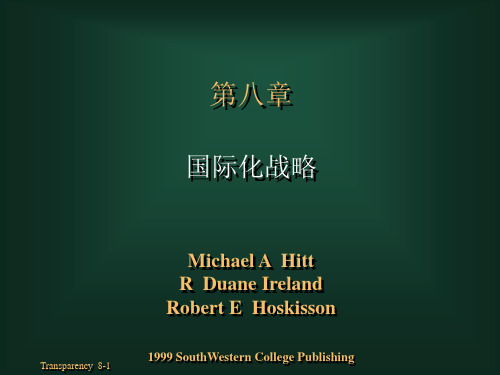
国际差异取胜
Transparency 8-25
经营级别的国际战略
国际低成本
通常在本国生产 出口至国际市场 在国外市场增加很少价值 高增值运营在本国进行
国际差异取胜
具有先进的或特殊的要素条件的国家一般采取这种战略
日本; 德国; 美国
国级际别Co的rpo国ra际te 战化略战略 多国化战略
Transparency 8-35
国级际别Co的rpo国ra际te 战化略战略 多国化战略
战略和经营决策下放到在每个国家的 战略经营单位 SBU
Transparency 8-36
国级际别Co的rpo国ra际te 战化略战略 多国化战略
战略和经营决策下放到在每个国家的 战略经营单位 SBU 产品和服务根据当地市场定制
波特的国家优势决定因素
本国的本质是国际化成功的关键
相关 & 支持工业
要素条件
基本要素 - 土地, 劳动力
高级要素 - 高学历的工人 - 数位通讯设施
一般要素 - 资金, 基础设施
特殊要素 - 具有技能的人力
Transparency 8-21
- 日本照相机 & 复印件 - 意大利皮鞋 & 皮件
需求要素
国际化战略生命周期
将产品或服务从的国内市场推向国际市场
2
产品需求增加; 开始出口产品
1 在国内市场
引进创新
3
国外竞争对手
开始生产
Transparency 8-9
4
开始在 海外生产
国际化战略生命周期
将产品或服务从的国内市场推向国际市场
2
战略管理英文课件 (1)
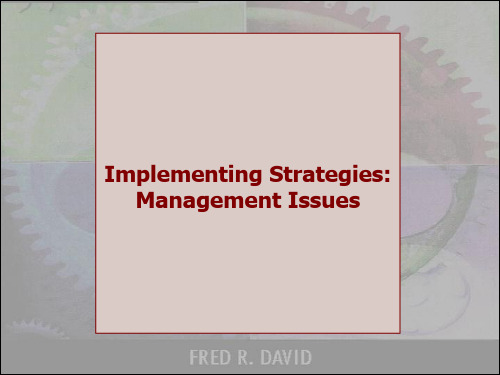
“In most organizations, the top performers are paid too little and the worst performers too much.”
—Cass Bettinger—
Successful strategy formulation does NOT guarantee successful strategy implementation!
Management Issues & Strategy Implementation
•
Production/ Operations Concerns
•
Production processes typically constitute more than 70% of firm’s total assets Decisions on:
Ø Ratios
out of line
•
Primary benefit = cost reduction
Management Issues & Strategy Implementation
•
Employee/customer well-being
Ø Redesign
Reengineering
•
work Ø Redesign jobs Ø Redesign processes
Transition to Strategy Implementation
ü
Shift in responsibility from strategists to divisional and functional managers
Ø Implementation
- 1、下载文档前请自行甄别文档内容的完整性,平台不提供额外的编辑、内容补充、找答案等附加服务。
- 2、"仅部分预览"的文档,不可在线预览部分如存在完整性等问题,可反馈申请退款(可完整预览的文档不适用该条件!)。
- 3、如文档侵犯您的权益,请联系客服反馈,我们会尽快为您处理(人工客服工作时间:9:00-18:30)。
Awareness Motivation Capability
Competitor Analysis
Market Commonality
Resource Similarity
Ability for Interfirm Rivalry: Action and Attack & Response Response
Capability
Ch5-7
Model of Interfirm Rivalry: Likelihood of Attack and Response
Exists when two or more firms jockey with one another in the pursuit of better market position
Ch5-4
Actions taken by one firm elicit responses from competitors
Chapter 13
Entrepreneurship
& Innovation
Strategic Actions
Strategic Outcomes
Feedback
Strategic Competitiveness Above Average
Returns
Ch5-2
Factors Leading to More Complex Rivalry
Chapter 8
International Strategy
Chapter 9
Cooperative Strategies
Strategy Implementation
Chapter 10 Corporate Governance
Chapter 12 Strategic Leadership
Chapter 11 Structure & Control
Chapter 5
Competitive Dynamics
Ch5-1
Strategic Inputs
Chapter 2 External Environment
Chapter 3 Internal Environment
Strategic Intent Strategic Mission
The Strategic Management
Advances in technology and innovation have increased competitiveness of small and medium sized firms
National barriers are falling due to the number and scope of trade agreements (GATT, NAFTA, EEC)
Process
Strategy Formulation
Chapter 4
Business-Level Strategy
Chapter 5
Competitive Dynamics
Chapter 6
Corporate-Level Strategy
Chapter 7
Acquisitions & Restructuring
Relative Size Speed
Innovation Quality
Feedback
Outcomes
Competitive Market Types Slow, Standard or Fast Cycle
Competitive Outcomes Sustained Competitive Advantage Temporary Advantage Evolutionary Outcomes Entrepreneurial Growth-Oriented or Market-Power
A firm’s strategic conduct
is dynamic in nature
Competitive Dynamics
Actions and responses shape the competitive positions
of each firm’s business level
strategy
Ch5-3
Competitive Dynamics
Results from a series of competitive actions and competitive responses among firms competing within a particular industry
Competitive Rivalry
Actions Ch5-6
Model of Interfirm Rivalry: Likelihood of Attack and Response
Drivers of Competitive
Behavior
Awareness
Motivation
Do managers understand the key characteristics of competitors?
Competitive responses lead
to additional actions from the
firm that acted originally
Ch5-5
Model of Interfirm Rivalry: Likelihood of Attack and Response
Drivers of Competitive
Likelihood of Attack First Mover Incentives
Likelihood of Response Type of Competitive
Action Actor’s Reputation Dependence on the
Market Resource Availability
Declining emphasis on single, domestic markets and increasing emphasis on global markets
Advances in communication technology make coordination easier across multiple markets
